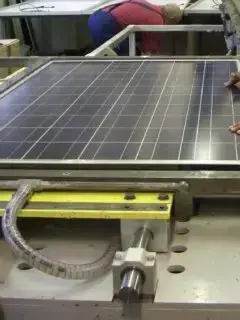Arizona solar panels are revolutionizing the way we generate electricity and pave the path for a sustainable future. Harnessing the abundant sunlight that Arizona is blessed with, these solar panels are playing a crucial role in the renewable energy landscape, promising a cleaner and greener tomorrow. Solar power refers to the conversion of sunlight into …
Solar
The Power of Solar Energy: A Bright Future for Clean Energy
To begin with, renewable energy sources are rapidly gaining momentum as a key solution to combat climate change and reduce dependence on fossil fuels. Among these sustainable alternatives, solar energy stands out as a frontrunner, offering numerous benefits and unparalleled potential for a greener future.
Solar energy, derived from harnessing the power of the sun, provides a clean and abundant source of power. It is a renewable energy resource that produces no greenhouse gas emissions, minimizing our carbon footprint and mitigating climate change. Apart from being environmentally friendly, solar energy is highly versatile and can be used to generate electricity, heat water, and power entire systems, making it a reliable and cost-effective solution.
Phenomenal Growth of Solar Energy
The solar industry is experiencing a phenomenal growth trajectory, with market trends reflecting a surge in solar installations worldwide. Advancements in technology have significantly reduced the costs associated with solar panels, making it more accessible and affordable for both residential and commercial purposes. As a result, solar energy has become an increasingly attractive option for individuals, businesses, and governments seeking sustainable energy solutions.
In addition to its environmental and economic advantages, solar energy plays a crucial role in achieving clean energy goals. As governments and organizations worldwide commit to transitioning to clean energy sources, solar power offers a scalable and scalable solution to reduce reliance on fossil fuels. Its potential for decentralization and independence from traditional energy grids also ensures resilience and energy security, particularly in remote or disaster-prone areas.
Tax policies and incentives have a significant impact on the adoption of solar energy. Governments worldwide are recognizing the importance of encouraging solar installations through various tax credits and initiatives. These policies aim to stimulate growth in the solar industry, making it more financially viable for individuals and businesses to invest in solar technology. By leveraging tax incentives, the widespread adoption of solar energy can be accelerated, bringing us closer to achieving a sustainable and carbon-neutral future.
Solar Power Generation
When it comes to harnessing the power of the sun, photovoltaic (PV) systems are at the forefront. Note that these innovative systems convert sunlight directly into electricity, revolutionizing the way we generate power.
Types of Solar Panels and Their Efficiency
Not all solar panels are created equal. There are several types available, each with their own advantages and efficiency levels. Monocrystalline panels, for example, offer high efficiency due to their uniform structure, while polycrystalline panels provide a more affordable option without compromising too much on efficiency.
Thin-film solar panels, on the other hand, use a different technology to convert sunlight into electricity and are more flexible in terms of where they can be installed. While their efficiency may be lower, their versatility makes them a popular choice in certain applications.
Solar Energy Applications in Residential, Commercial, and Industrial Sectors
The applications of solar energy are vast and span across various sectors. In residential settings, solar power can be used to generate electricity for households, reducing reliance on traditional power grids and lowering energy bills.
As I have noted, commercial and industrial sectors can also benefit from solar power, with large-scale installations powering offices, factories, and warehouses, reducing their carbon footprint and operating costs.
Overview of Solar Thermal Systems and Their Advantages
While photovoltaic systems generate electricity, solar thermal systems harness the sun’s heat to provide hot water and space heating. These systems utilize collectors to capture the sun’s energy, transferring it to water or a heat transfer fluid. Solar thermal systems offer advantages such as reduced reliance on fossil fuels and lower energy costs in buildings and industries with high hot water demand.
Role of Solar Battery Storage in Maximizing Solar Energy Utilization
Solar battery storage plays a crucial role in maximizing the utilization of solar energy. It allows excess energy generated by solar panels to be stored for use during periods of low sunlight or high electricity demand. This ensures a continuous power supply and increases the overall efficiency and reliability of solar power systems. Additionally, solar battery storage can help to reduce reliance on the grid and make the most of renewable energy.
Solar Installation and Maintenance
Installing and maintaining a solar energy system is essential for harnessing the full potential of solar power.
And so in this section, we will provide you with a step-by-step guide to the solar installation process, discuss considerations for system sizing and placement, highlight the importance of regular maintenance, and mention safety measures and regulations you need to be aware of.
We will also provide you with some handy tips for troubleshooting common solar system issues.
Step-by-step guide to solar installation process
Installing a solar energy system involves several key steps. Here’s a simplified guide to help you understand the process:
- Site assessment: Firstly, a solar installer will evaluate your property to determine its suitability for solar installation. Factors like roof condition, shading, and available space will be assessed.
- System design: Secondly, based on the site assessment, a custom solar system design will be created to meet your specific energy needs.
- Permitting and paperwork: Thirdly, the necessary permits and paperwork will be handled by your solar installer to ensure compliance with local regulations.
- Installation: The solar panels, inverters, and other components will be installed on your roof or ground-mounted on your property.
- Electrical connections: The solar panels will be connected to your existing electrical system, allowing you to start generating solar power.
- Inspection and activation: Finally, a final inspection will be conducted to ensure the system is installed correctly and safely. Once approved, your solar energy system will be activated.
Considerations for solar system sizing and placement
When it comes to sizing and placing your solar system, a few factors should be taken into account:
- Energy needs: Determine your average energy consumption to size your solar system accordingly. Consider future changes and seasonal variations.
- Roof orientation and tilt: Solar panels work best when they face south and are tilted at an angle that maximizes sunlight exposure.
- Shading: Avoid shading from trees, buildings, or other objects that can restrict sunlight access to your solar panels.
- Available space: Finally, assess the available roof or ground space to determine how many solar panels can be installed.
Importance of regular maintenance for optimal performance
To ensure your solar system operates at its peak performance and maximizes your return on investment, regular maintenance is crucial. Here are some reasons why:
- Efficiency optimization: Regular inspections and cleaning help remove dirt, debris, and any potential obstructions that may affect the efficiency of your solar panels.
- Early issue detection: Regular maintenance allows for the early detection of any potential issues or performance abnormalities, enabling timely repairs.
- Longevity: By all means, proper maintenance can extend the lifespan of your solar system, ensuring it continues to generate sustainable energy for many years to come.
Safety measures and regulations in solar installation
Solar installation involves working with potentially hazardous electrical equipment. It is vital to follow safety measures and adhere to regulations to protect yourself and others. Here are some important aspects to consider:
- Hiring a professional: Always engage a licensed and experienced solar installer to handle the installation process.
- Electrical safety: Ensure that only qualified electricians make the necessary electrical connections to minimize any electrical hazards.
- Compliance: Familiarize yourself with the local regulations and building codes related to solar energy installations to ensure compliance.
Tips for troubleshooting common solar system issues
Occasionally, solar systems may encounter common issues that can be resolved with some troubleshooting. Here are a few handy tips to help you address these issues:
- Monitor system performance regularly to detect any sudden drops in energy generation.
- Check for loose connections or damaged wires that may affect the flow of electricity.
- Clean the solar panels regularly to remove dirt, dust, or debris that can hinder their performance.
- Keep an eye out for any error messages or warning indicators on your solar inverter and consult the manufacturer’s manual for guidance.
By following these tips, you can swiftly identify and resolve common solar system issues, ensuring the continuous and efficient operation of your solar energy system.
Solar Energy Efficiency
Solar energy efficiency plays a crucial role in maximizing the benefits of solar power. By focusing on improving efficiency, we can ensure that every ray of sunshine is harnessed to its full potential.
Importance of maximizing solar energy efficiency
Maximizing solar energy efficiency is essential for both environmental and economic reasons. When solar systems operate at their highest efficiency, it means that more energy is being generated from the same amount of sunlight, reducing the overall environmental impact. Additionally, higher efficiency translates to greater cost savings as more energy is produced per unit of sunlight.
Factors influencing solar energy conversion rates
Several factors impact the conversion rates of solar energy. The angle and orientation of solar panels, geographical location, weather conditions, and the quality of solar panels are a few vital considerations. It’s crucial to take these factors into account to ensure optimal energy conversion and maximize efficiency.
Innovations and technologies improving solar panel efficiency
The solar industry is continuously evolving, with technological innovations driving significant improvements in solar panel efficiency. Advances in the design and manufacturing processes, as well as the use of advanced materials and coatings, have enabled solar panels to convert sunlight into usable energy more effectively. These innovations contribute to enhancing overall solar energy efficiency.
Strategies for optimizing solar system performance
There are various strategies that can be employed to optimize solar system performance and increase energy efficiency. Regular maintenance, including panel cleaning and inspection, can ensure that the system operates at peak efficiency. Additionally, using tracking systems that adjust the position of panels to track the sun’s movement throughout the day can dramatically enhance energy production.
Case studies highlighting successful energy-saving initiatives
- Case Study 1: Company XYZ implemented energy-saving initiatives by integrating advanced monitoring systems to track system performance in real-time. This monitoring allowed for timely identification of potential issues and corrective actions, resulting in improved energy efficiency.
- Case Study 2: Community ABC installed energy storage systems alongside their solar panels, allowing excess energy to be stored for later use. This practice not only increased energy efficiency but also provided a reliable source of power during periods of low solar generation.
Solar Industry and Market Trends
The solar industry in America has experienced rapid growth in recent years. With the increasing demand for renewable energy sources, solar power has emerged as a key player in the energy sector. In this section, we will explore the current state of the solar industry and its market trends.
Overview of the Solar Industry in America
The solar industry in America is thriving, with numerous companies engaged in the production and installation of solar panels. As more individuals and businesses recognize the importance of transitioning towards clean energy, the demand for solar power has skyrocketed. This has resulted in job creation and economic growth in the solar sector.
Market Growth and Investment Opportunities in Solar Sector
The solar sector presents vast investment opportunities due to its consistent growth. The market for solar power has expanded significantly over the past decade, attracting investors from various industries. Investing in solar companies and projects can be a profitable venture, contributing to both financial returns and environmental sustainability.
Emerging Trends and Advancements in Solar Technology
Solar technology has evolved rapidly over the years, leading to the development of more efficient solar panels and systems. Emerging trends include the integration of solar power with energy storage solutions and smart grid technologies. Advancements in solar technology aim to enhance energy generation, storage, and utilization, making solar power more accessible and reliable.
Challenges and Potential Solutions for the Solar Industry
Despite the significant growth of the solar industry, it faces various challenges. Some of these challenges include high upfront costs, intermittent energy generation, and limited storage capacity. However, researchers and industry experts are continuously working towards addressing these issues. Innovations like reduced manufacturing costs, improved energy storage systems, and grid integration are potential solutions to overcome these challenges.
Role of Government Policies and Incentives in Shaping the Solar Market
Government policies and incentives play a crucial role in shaping the solar market. In America, federal, state, and local governments provide various incentives to promote solar energy adoption. These incentives include tax credits, grants, and rebates, making solar power more affordable and attractive to individuals and businesses. Government regulations also influence the growth and deployment of solar power across the country.
Solar Energy Applications
Solar energy has abundant applications in various sectors, offering numerous benefits to homeowners, businesses, and even the transportation industry. Here are some key areas where solar power is utilized:
Residential Solar Applications and Benefits for Homeowners
- Roof-mounted solar panels provide a clean and sustainable energy source for residential properties.
- Homeowners can significantly reduce their electricity bills by generating their own solar power.
- Solar energy systems increase the value of properties and attract environmentally conscious buyers.
- Off-grid solar solutions enable homeowners to be self-sufficient and independent from the traditional energy grid.
Commercial and Industrial Solar Solutions for Businesses
- Commercial buildings can install solar panels on their rooftops, reducing their reliance on traditional energy sources and lowering operational costs.
- Industrial facilities can benefit from large-scale solar systems to power their operations, ensuring a greener and more sustainable production process.
- Businesses investing in solar energy demonstrate their commitment to corporate social responsibility and can gain positive brand reputation.
Large-Scale Solar Projects and their Impact on the Energy Grid
- Large-scale solar projects, such as solar farms and solar power plants, contribute significantly to the overall energy supply.
- These projects integrate with the energy grid, reducing the need for fossil fuel-based power plants and decreasing greenhouse gas emissions.
- Excess solar energy can be stored or distributed to neighboring areas, ensuring a stable and reliable energy supply.
Solar-Powered Transportation and its Potential
- Solar energy can power electric vehicles, reducing the dependency on fossil fuels for transportation.
- Solar-powered vehicles offer a sustainable and cost-effective alternative, contributing to a cleaner environment and reducing carbon emissions.
- Ongoing research and development aim to enhance the efficiency and range of solar-powered transportation options.
Solar Energy and Building
Integration of solar energy systems in building design and construction
One of the key advancements in renewable energy is the integration of solar energy systems in building design and construction. By incorporating solar panels into the infrastructure of buildings, we can harness the power of the sun and reduce our reliance on traditional energy sources.
Benefits of solar energy for green buildings
Solar energy provides numerous benefits for green buildings. Firstly, it offers a clean and renewable source of electricity, reducing greenhouse gas emissions and mitigating climate change. Additionally, solar energy can help buildings achieve energy independence and reduce their electricity bills, resulting in long-term cost savings.
Innovative solar building materials and technologies
The solar energy industry has seen a rise in innovative building materials and technologies designed specifically for solar integration. This includes solar roof tiles, solar windows, and even solar-powered paint. These advancements allow buildings to seamlessly incorporate solar energy systems while maintaining aesthetic appeal.
Case studies of solar-powered buildings in America
Across America, there are numerous case studies showcasing the successful implementation of solar-powered buildings. From large commercial structures to residential homes, these buildings demonstrate the viability and effectiveness of solar integration. They serve as inspiration and provide tangible examples for future solar energy projects.
Future of solar integration in urban planning and architecture
The future of solar integration in urban planning and architecture looks promising. With the growing emphasis on sustainable development and renewable energy, more cities are incorporating solar energy requirements into building codes. Architects are also embracing solar design principles, integrating solar panels and systems into their blueprints from the start.
Conclusion
Harnessing the power of the sun is not only a sustainable choice for our energy needs but also a decision that brings numerous benefits. Solar energy offers a clean and renewable solution that significantly reduces greenhouse gas emissions, helping combat climate change and preserve our planet for future generations.
By adopting solar energy solutions, we can save on electricity costs and decrease our dependence on fossil fuels. Solar panels can be installed on rooftops, in open fields, or even integrated into building materials, making them versatile and adaptable to various environments.
We encourage everyone to consider the advantages of solar energy and take the necessary steps towards incorporating it into their lives. Whether it is adopting solar power for residential or commercial use, the long-term benefits will not only contribute to a greener future but also generate substantial savings in electricity expenses.
The solar industry is continuously evolving, with advancements in technology and increasing market demand driving innovation and efficiency. As a result, the industry holds great promise for creating job opportunities and positively impacting America’s energy landscape. Embracing solar power will contribute to creating a sustainable and resilient energy system.
In conclusion, solar energy is a key player in the clean energy transition and offers a renewable alternative that benefits both individuals and the broader community.
Let us embrace solar power and be a part of the solution for a greener and brighter future.
And in case of any inquiries, please Contact Us and let us know how we can help. Learn more About Us.
Welcome to the groundbreaking world of California Solar Panels! As the leading state in solar energy, California has set ambitious clean energy goals, aiming to make use of renewable energy sources. Embracing the power of the sun, these goals have propelled this sunny state to the forefront of the clean energy movement. With its abundant …
Are you looking to upgrade your roof while also reducing your carbon footprint with GAF Timberline solar shingles? Look no further than GAF Solar Roof Shingles! These innovative shingles not only protect your home from the elements but also harness the power of the sun to provide clean, renewable energy. Let’s dive into what GAF …
CertainTeed, the makers of CertainTeed solar shingles, has been a trusted and reputed brand in the construction industry for decades. With a commitment to innovation, quality, and sustainability, CertainTeed has gained recognition for its top-notch products and solutions. In line with its dedication to providing innovative roofing solutions, CertainTeed introduces its exceptional line of solar …
In today’s world, solar energy has emerged as a sustainable and effective solution to combat climate change and reduce reliance on fossil fuels. At the heart of this clean energy revolution lies solar manufacturing, which plays a crucial role in harnessing the power of the sun and converting it into usable electricity. A. Definition and Overview: Solar …





